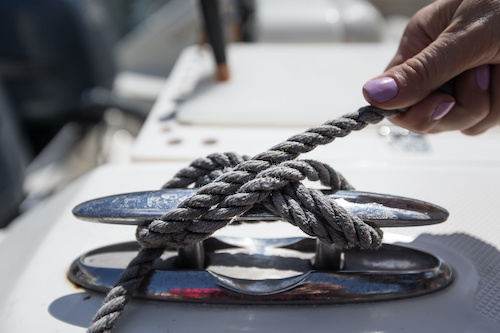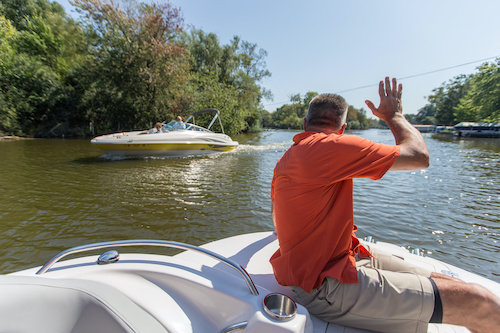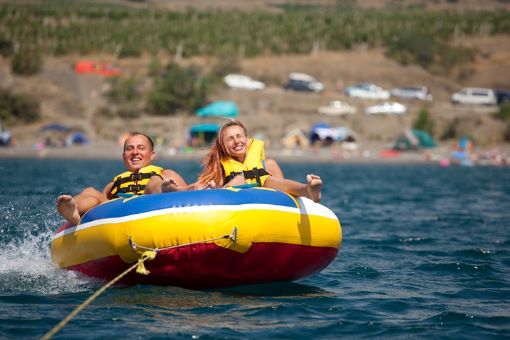Boating can be a social affair. There are dozens of ways to enjoy party time on your boat, but one of the best is undoubtedly rafting up with other boats and celebrating the boating lifestyle together.
Whether you’re ready to relax after a fun afternoon of watersports or your day cruising adventure brought you to the destination known as your own local “Party Cove,” when you do raft up, make sure you go about it the right way—and in a safe way.
7 Quick Tips for Rafting Up with Another Boat
- The largest, heaviest boat should drop its anchor first, and serve as the building block for other boats to tie up along either side.
- Slow down when approaching or joining a raft up, as to avoid any potentially damaging collisions.
- Make sure all passengers keep their hands and feet in the boat while rafting up, so they don't get pinched.
- Always secure boats to one another using the cleats—not rail stations, handrails, or other accessories.
- Remember to deploy your fenders before approaching another boat to raft up.
- Keep the lines tied between boats as tight as possible to minimize motion between the boats.
- Try your best to raft together with boats that are a similar size, and position your vessels so your swim platforms are aligned.
Now that we've covered some of the basics on how to raft up, let's dive deeper into some of the details.
How to Beach a Boat: 10 Tips for Anchoring on a Sandbar
How to Properly Tie Up Boats When Rafting Up
If you’ve never rafted up your boat before, you may be wondering if it’s as simple as it looks: boats tie up to one another, and everyone has fun… right? Well, more or less. But in order for the raft up to be successful there are a few basics to keep in mind.
The first relates to how you’ll keep your raft of boats in place.
- The largest, heaviest boat in the raft should drop its anchor, prior to anyone tying up. That boat serves as the basic building block, or the foundation, of the entire raft.
- Once its anchor is set, other boats can then tie up alongside.
- It’s important, however, for boats to alternate sides as they join up with the raft. With the anchor in the middle of the raft the boats tend to swing the least amount and with equal tension on the lines.
How to Anchor a Boat: Step-by-Step Guide
Also important is exactly how you secure the boats together.
- Naturally, you’ll want to deploy fenders before approaching another boat to raft up with it.
- There’s no hard rule as to how many you need, but plan on using at least one fender for every 10 feet of LOA, and more never hurts.
- With the fenders in place you can tie the bows and sterns of the boats together, but also run lines from the bow of one boat to the stern of the other (or an amidships cleat), to minimize fore and aft motion.
- Creating an “X” shape with lines between the two boats is best.
How to Tie Up a Boat: Mooring Guide
Common Raft Up Mistakes
The biggest mistake many people make when they raft up is leaving the lines between the boats too loose. You want the boats to rise, fall, and rock more or less together, and having the lines as tight as possible is the best way to minimize motion between the boats. So after initially securing the lines it’s always a good idea to go back and tighten them all up.
Another mistake people sometimes make when rafting up is not paying attention to the size of the different boats as they slide in next to each other.
- As a general rule of thumb, it’s always best for boats of similar sizes to be located next to each other. That’s because boats of very different sizes may have their rubrails at very different heights.
- Similarly, when possible, it’s best to raft similar boat types next to one another. Pontoon boats, for example, are likely to sit very differently than wakeboard boats. That’s not to say that they can’t raft up together, but if you locate the pontoons next to pontoons and wakeboard boats next to wakeboard boats, everyone’s fenders and rubrails will probably match up a lot better.
12 Common Boating Mistakes & How to Avoid Them
Raft Up Safety Tips
Whenever you’re on the water safety is important, but this is especially so when multiple boats converge on the same location. Not only does the close proximity between rafted boats introduce the potential for dings and scrapes on your prized possession, it also creates some unique safety issues.
So whether you’re rafting up your own boat or just cruising past a raft up, always remember:
- Slow down when approaching or joining a raft up. Large wakes are the main cause of problems, so minimizing your wake is a big deal.
- Never cut between a raft of boats and a beach, since many people will likely be swimming back and forth in the area. For the same reason, always go past a raft of boats at the bow side, never by the sterns of the boats where people may be in the water.
- Make sure everyone aboard knows not to put their hands or feet between rafted boats, so they don’t get pinched.
- Always try to raft together with your neighbors so your swim platforms are aligned. That way if someone wants to go from boat to boat, they can walk along the platforms instead of trying to climb from one boat to the next.
- Always secure boats to one another using the cleats, not rail stations, handrails, or other accessories. These may seem like they provide a convenient place to tie things up, but won’t be as secure as a cleat and may break or rip free of the fiberglass. Then, the boats won’t be safely secured and additional damage or even injury becomes more likely.
- Be aware of carbon monoxide levels and the potential for exhaust buildup. Read our full safety guide on Carbon Monoxide (CO) Poisoning and Electric Shock Drowning (ESD) to learn more.
The Ultimate Boating Safety Guide
Rafting Up Etiquette & Best Practices to Keep in Mind
Rafting up with other boaters is a thoroughly social affair, so naturally, everyone will want to treat each other politely. Here are a few courtesy items to keep in mind:
- Arrive with your batteries in a state of full charge and don’t leave your engine(s) or generator running while rafted up. They can be noisy and smelly when a number of boats are all together, and may annoy your neighbors.
- Huge raft ups can form in some areas, and you may not know your immediate raft-neighbor. In this case, one should always ask permission before coming alongside.
- Consider others when tuning in and turning up your stereo.
- Particularly when families with kids are nearby, be sure to use appropriate language.
- As is always the case when boating, make sure there’s a sober skipper at all times.
For many people, boating is often enjoyed with a limited number of family and/or friends. Rafting up lets you greatly expand your social horizons—and it won’t take long to realize that it’s also a lot more fun to socialize while rafted up on the water than it is at any boring old party on land.



